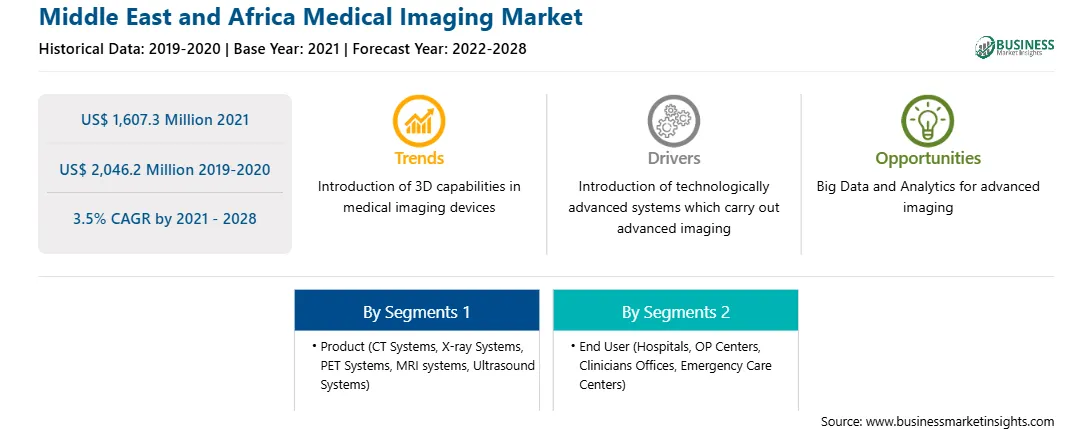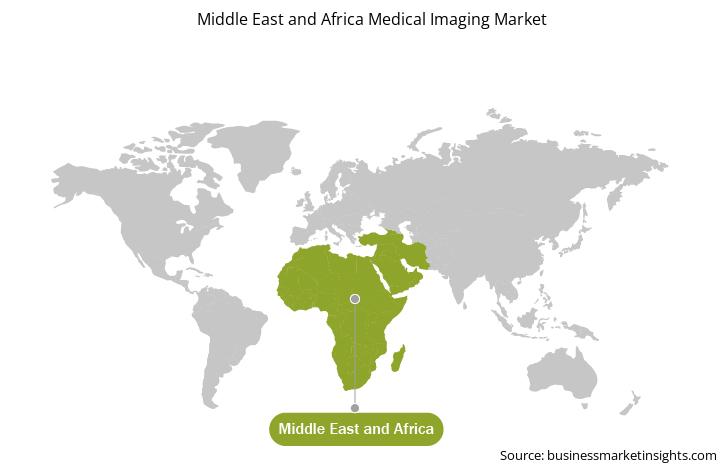Medical imaging refers to techniques and processes used to create images of various parts of the human body for diagnostic and treatment purposes within digital health. The term, medical imaging, includes various radiological imaging techniques such as: X-ray radiography, Fluoroscopy, Magnetic resonance imaging (MRI), Medical ultrasonography or ultrasound, Endoscopy, Elastography, Tactile imaging, Thermography, Medical photography and nuclear medicine functional imaging techniques e.g., positron emission tomography (PET). Medical imaging is crucial in every medical setting and at all levels of healthcare.
Thus, the increasing demand for early diagnosis are expected to create a significant demand for medical imaging in the coming years, which is further anticipated to drive the medical imaging market.
Countries like UAE and Saudi Arabia have also registered many positive coronavirus infection cases. These regions are developing in terms of the healthcare and medical service industry. The countries in these regions are highly dependent on medical devices imported from developed countries. Therefore, countries have faced several challenges with their requirements for medical imaging systems due to severe disruption in supply chains. Health authorities are worrying that attempting to fight the coronavirus will indirectly contribute to an increase in deaths of ill patients, including cancer patients, gynecology patients, and other causes. The death pool of ill patients in low-cost regions is expected to increase because healthcare professionals are having limited their patients checking as many clinics as possible, diagnostic centers, ambulatory surgery centers have limited resources and staff. However, there has been a spur in demand for imaging modalities such as computed tomography and ultrasound systems to manage the treatment of patients suffering with COVID-19. Countries were severely hit by the pandemic and deployed large number of chests imaging every single day. These factors thus encouraged the growth of the medical imaging market in this region.

Strategic insights for the Middle East and Africa Medical Imaging provides data-driven analysis of the industry landscape, including current trends, key players, and regional nuances. These insights offer actionable recommendations, enabling readers to differentiate themselves from competitors by identifying untapped segments or developing unique value propositions. Leveraging data analytics, these insights help industry players anticipate the market shifts, whether investors, manufacturers, or other stakeholders. A future-oriented perspective is essential, helping stakeholders anticipate market shifts and position themselves for long-term success in this dynamic region. Ultimately, effective strategic insights empower readers to make informed decisions that drive profitability and achieve their business objectives within the market.

| Report Attribute | Details |
|---|---|
| Market size in 2021 | US$ 1,607.3 Million |
| Market Size by 2028 | US$ 2,046.2 Million |
| Global CAGR (2021 - 2028) | 3.5% |
| Historical Data | 2019-2020 |
| Forecast period | 2022-2028 |
| Segments Covered |
By Product
|
| Regions and Countries Covered | Middle East and Africa
|
| Market leaders and key company profiles |
The geographic scope of the Middle East and Africa Medical Imaging refers to the specific areas in which a business operates and competes. Understanding local distinctions, such as diverse consumer preferences (e.g., demand for specific plug types or battery backup durations), varying economic conditions, and regulatory environments, is crucial for tailoring strategies to specific markets. Businesses can expand their reach by identifying underserved areas or adapting their offerings to meet local demands. A clear market focus allows for more effective resource allocation, targeted marketing campaigns, and better positioning against local competitors, ultimately driving growth in those targeted areas.

The Medical imaging market in Middle East and Africa is expected to grow from US$ 1,607.3 million in 2021 to US$ 2,046.2 million by 2028; it is estimated to grow at a CAGR of 3.5% from 2021 to 2028. The use of 3D (and potentially even 4D) technologies in diagnostic radiology can create better images, for powerful results. Though ultrasounds are very popular in the medical field, they are limited by the inability to obtain high-resolution, detailed images. Using 3D technology, it is possible to improve ultrasound resolution, and enhance patient care. Experts at CareStream Health, a leader in digital medical solution and IT infrastructure for healthcare, have also been exploring 3D capabilities in imaging, specifically in CT scans. The software in their OnSight 3D Extremity System increases the contrast of soft tissue and reduces the visibility of metal artifacts compared to traditional CT images. These improvements enable sharp 3D construction and lead to a better understanding of patient health.
In terms of product, the X-ray systems segment accounted for the largest share of the Middle East and Africa medical imaging market in 2020. In terms of end user, the hospitals segment accounted for the largest share of the Middle East and Africa medical imaging market in 2020.
A few major primary and secondary sources referred to for preparing this report on the medical imaging market in Middle East and Africa are company websites, annual reports, financial reports, national government documents, and statistical database, among others. Major companies listed in the report are General Electric Company, Siemens AG, Koninklijke Philips N.V., Shimadzu Corporation, Hitachi, Ltd., Canon Inc., Hologic, Inc., Carestream Health Inc., and Samsung Group.
By Product
By End User
By Country
The Middle East and Africa Medical Imaging Market is valued at US$ 1,607.3 Million in 2021, it is projected to reach US$ 2,046.2 Million by 2028.
As per our report Middle East and Africa Medical Imaging Market, the market size is valued at US$ 1,607.3 Million in 2021, projecting it to reach US$ 2,046.2 Million by 2028. This translates to a CAGR of approximately 3.5% during the forecast period.
The Middle East and Africa Medical Imaging Market report typically cover these key segments-
The historic period, base year, and forecast period can vary slightly depending on the specific market research report. However, for the Middle East and Africa Medical Imaging Market report:
The Middle East and Africa Medical Imaging Market is populated by several key players, each contributing to its growth and innovation. Some of the major players include:
The Middle East and Africa Medical Imaging Market report is valuable for diverse stakeholders, including:
Essentially, anyone involved in or considering involvement in the Middle East and Africa Medical Imaging Market value chain can benefit from the information contained in a comprehensive market report.